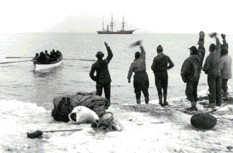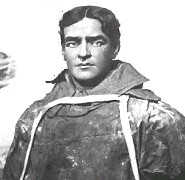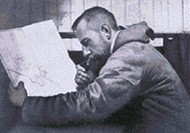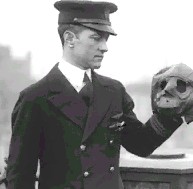Robert F. Scott's 'Discovery' expedition early in the 1900's made an initial attempt to reach the Pole. Although they made it further than any previous expedition, they were unable to make it all the way.
In 1908, Ernest Shackleton, one of the members of Scott's first party, returned to the Antarctic as leader of the 'Nimrod' expedition, and came to within 150 km of the Pole before returning to base at McMurdo Sound.
Then a Norwegian expedition, led by Roald Amundsen, along with a second expedition by Scott, set out for the South Pole. It became a race.
The race ended on December 14, 1911, when Amundsen and four others arrived at the South Pole after an uneventful and carefully prepared overland journey. Their return also went without problems. It didn't go so well for Scott's party, however.
Scott and four companions reached the Pole a month later, to find the tent and flag of the Norwegian explorer already in place. But there had been problems with the cold from the beginning of the expedition, and then, weakened by the difficult return journey, Scott and his companions all died. Henry R. Bowers, Dr. Edward Wilson, and Scott all perished of starvation and exposure on March 29, 1912, within 18 km of a supply depot. Their bodies, along with valuable documents and specimens left by Scott in his tent, were found by a search party almost eight months later. His diaries and other documents were published as 'Scott's Last Expedition' in 1913.
The next visit to South Pole occurred in 1929 when Richard E. Byrd, Jr. flew over the Pole and threw an American flag and other mementos out the window of his Ford Trimotor airplane. During his first expedition to Antarctica, from 1928 to 1930, Byrd established a base, Little America, on the Bay of Whales. From this base, extensive mapping of the continent took place, along with the discovery of the 'Edsel Ford Mountain Range', and 'Marie Byrd Land'.
Byrd led a second expedition to the Antarctic from 1933 to 1935. During that expedition Byrd conducted meteorological and auroral research, alone in a shack for five months, 196 km south of Little America.
During his third expedition, from 1939 to 1940, four exploratory flights were made, resulting in many discoveries.
In a fourth Antarctic expedition from 1946 to 1947, Byrd explored and mapped approximately 2,188,500 sq km of territory, about one-third of it newly discovered.
In 1955 Byrd was appointed head of 'Operation Deep-Freeze', an Antarctic expedition organized by the United States in connection with the International Geophysical Year (1957-1958).
|

Scott's exploration party

Ernest Shackleton

Roald Amundsen

Richard E. Byrd
|

